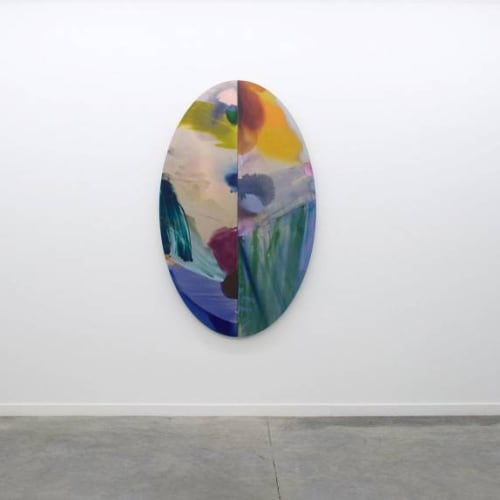Pamela Jorden’s show Forest is full of diptychs, but not the kind of diptychs we’re used to. We’d typically picture two rectangular canvases of equal size hung snugly beside each other, like San Francisco houses and their zero lot lines. Or, in an art historical context, an altarpiece with two hinged sides. But in truth, “diptych” simply means “a work made up of two matching parts.” And in Jorden’s hands, how they those parts match—or fit together—is by no means typical.
Forest fills Romer Young Gallery with big stretched linen shapes and big swatches of color. It’s the Los Angeles artist’s fifth solo exhibition with the gallery, and she knows exactly how to use the space. Jorden’s six diptychs reject 90-degree angles for bisected circles, elegant curves and mirror-like ovals. The one rectangular canvas, Vine, is actually two tall and slim pieces that fit together like a satisfying puzzle, muted gray on the left, a saturated blend from yellow to cobalt on the right, a sinuous curve running between.
Even when Jorden’s acrylic and oil paintings comprise two equal parts, as in the circular Dusking and mirror-like Stone, they transcend their binary nature. Vibrant colors spill across surfaces and onto curved edges, mingling in liquid pools and translucent washes—the linen always visible in the spaces between thin layers of paint. The soft, possibly still-mutable nature of her compositions meets the precise edges of stretched shapes, some of which are completely unexpected. Tine is like two air-filled sails, Bow an abstract rendering of its titular object. Of all the artists who have worked with shaped canvases, I was reminded most of Harvey Quaytman, who dammed up the edges of his pigmented surfaces with barriers of aluminum tape, as if the paintings struggled against containment.
If there are strict delineations in Forest, they come not from the compare-contrast of two opposite canvases, but like Quaytman’s work, from the world within Jorden’s paintings and the world outside her paintings. (Even the negative space of a crescent created by the two parts of Moons can be incorporated into the whole.)

